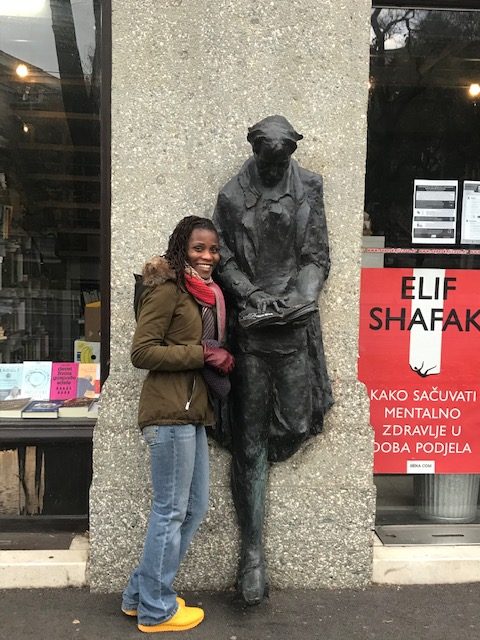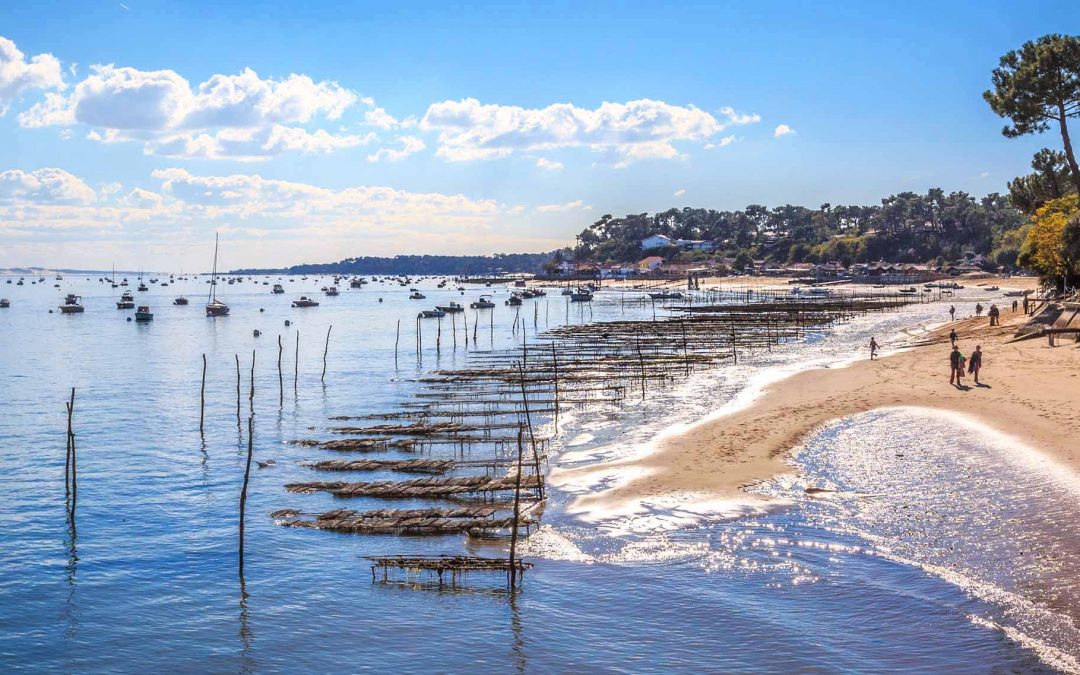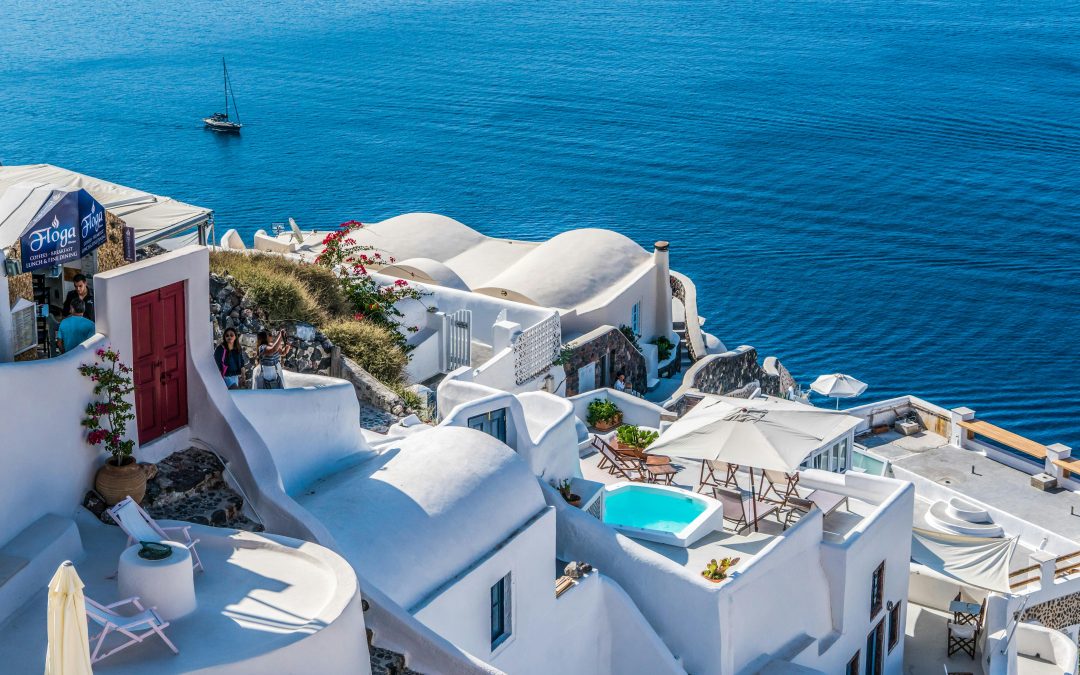
SANTORINI — New Cruise Fees & Caps, Crowd‑Proof Routes, and How to See the Island Beautifully (and Sustainably)
Santorini’s caldera is a crescent of obsidian cliffs fallen in love with light. But it’s also a laboratory for the future of tourism—where Greece is testing fees, caps, and smarter crowd management to keep a fragile island both livable and magical. If you’re planning Santorini in 2025, this deep‑dive shows you exactly how to navigate the new rules, beat the queues, and still find your own quiet corners of blue and white.
1) What Changed for 2025 (and Why It Matters)
Santorini and its sister hotspot Mykonos have spent the last few years at the center of a global conversation on overtourism. In 2023 alone, Santorini hosted around 800 cruise ship calls bringing 1.3 million cruisers into a permanent‑resident population of roughly 15,500—a mismatch that strains streets, water, waste systems, and the very experience people come for. In response, the Greek government announced a package of measures geared to price, cap, and manage cruise flows more assertively from 2024–2025 onward. That includes a €20 cruise passenger fee for Santorini and Mykonos (lower fees for other ports) beginning in 2025, and the intent to limit berths/anchoring slots—with the prime minister naming Santorini and Mykonos as the top priorities for stricter control.
The cruise‑fee reform is part of a broader sustainability push that also raises the seasonal lodging tax and explores daily passenger caps; coverage through late 2024 and 2025 emphasized that Santorini’s target daily cap for cruise visitors is 8,000 passengers, combined with practical bottlenecks at the port itself. The island has additionally enforced operational throttling at the tender dock—limiting the number of passengers allowed to wait on the dock to about 500 at a time, with cruise tenders slowed until the queue clears. That throttling is meant to avoid unsafe crushes at the base of the cable car and in the stairway corridor (Karavolades Steps) leading to Fira.
Why you should care as an independent traveler: these measures dramatically reshape peak‑hour flows. Even if you’re staying on the island, your sunset in Oia, your cable‑car wait, or your rental‑car pickup can be affected by cruise arrival patterns and dock management. Understanding when and where congestion forms is now as essential as choosing a hotel with a view.
Key 2025 changes at a glance
- €20 cruise passenger fee at Santorini/Mykonos starting 2025; lower fees at other Greek cruise ports. Revenue supports climate resilience and infrastructure.
- Daily cruise passenger cap targeted at ~8,000 for Santorini (policy direction signaled), with berth/slot limits anticipated to meter calls.
- Dock throttling: limit of ~500 people queued on the tender dock at any one time to reduce unsafe crowding and cable‑car congestion.
- Seasonal lodging tax increases (peak months) to spread demand and raise funds for local resilience.
Bottom line: Santorini is not “closed to cruises,” but flows are being priced and metered. For you, that means smarter timing—not skipping the island.
2) When to Come: A Season‑by‑Season, Crowd‑Smart View
Late April–June (shoulder to early peak):
- Weather is warm but not blazing; Aegean winds are gentler than in high summer.
- Cruise calls ramp up steadily—midweek dawns are calmer than Saturdays. Check the Santorini cruise calendar (many lines publish schedules) to time Oia or the Fira cable car outside mega‑ship mornings.
July–August (peak):
- Meltemi winds can be strong, skies are clear, and crowds spike. This is where the dock throttling and cruise passenger fee are most visible in practice: if multiple large ships are tendering, expect long waits at the dock and the cable car. On days with three or more large ships, you may see tender slowdowns and staggered shore‑leave. Plan your Fira/Oia hours well away from the 10:30–16:30 band.
September–October (sweet spot):
- Seas are warm, vineyards are in harvest, and sunsets still golden without the July crush. The daily rhythm is calmer, and the new port controls + fee regime may already be smoothing spikes late in the season.
November–March (quiet beauty):
- Cooler, some businesses pause, but caldera hikes and the Akrotiri excavation are far more contemplative. If you’re writing or photographing, winter light + fewer people is perfection. Shorter days: plan transfer buffers if winds cancel ferries.
3) Where to Stay (So You Spend More Time Savoring, Less Time Queuing)
Fira (Thira): Central and connected; great for first‑timers who want to ride buses and sample nightlife. The cable car lands here from the tender dock, so mid‑day can be intense—but if you’re staying in Fira, you can avoid moving when the peak hits.
Imerovigli: Still on the caldera path, but quieter than Oia and Fira. It’s the highest village along the rim, with stairways to secret terraces facing the Skáros Rock buttress. You’ll get high‑drama views without the scrum. Perfect for honeymooners and writers.
Oia: Iconic domes, tight alleys, legendary sunset. It’s also where the sunset crush is fiercest. Book Oia if your hotel faces the sunset directly and you’re committed to early‑morning wanders; otherwise, consider sleeping in Imerovigli and visiting Oia at dawn.
Pyrgos or Megalochori: Inland, traditional villages with breweries, bakeries, and courtyards. You can drive to viewpoints and beaches—with a quiet home base that dodges the caldera crowds. Ideal with a rental car.
Akrotiri area: Sleep near Red Beach and the Bronze‑Age ruins; great for south‑coast sunset at the lighthouse, and easier parking. You’ll trade a 20–40‑minute drive to Fira/Oia for calmer days.
Hotel pick strategy for 2025: Choose free‑cancellation rates (cruise slot allocations can alter daily rhythms), check walkability (stairs are everywhere), and confirm luggage help—porter support is worth its weight in gold in multilevel villages.
4) The Crowd‑Proof Itineraries (Three Days, Multiple Ways)
A) The “Slow Caldera” (3 Days based in Imerovigli or Pyrgos)
Day 1—Orient + Breathe
- Sunrise walk: Imerovigli → Skáros Rock viewpoint. You’ll have long blue light and almost no one on the path.
- Coffee with a view in Imerovigli, then mid‑morning museum hour in Fira (Archaeological Museum, Museum of Prehistoric Thera).
- Early lunch in Fira; siesta during 12:00–15:00 when tender flows peak.
- Golden‑hour walk from Imerovigli to Firostefani and back; dinner facing the caldera.
Day 2—South Loop & Akrotiri
- Akrotiri Excavations at opening time (Bronze‑Age frescoes, urban planning, astonishing engineering).
- Red Beach overlook (don’t scramble unstable slopes), Vlychada for the sculpted pumice cliffs.
- Sunset at Akrotiri Lighthouse with far fewer people than Oia. Bring layers; the headland catches wind.
Day 3—Oia at Dawn + Winery Afternoon
- Oia before sunrise: the alleys are yours; catch domes glowing pink and the bell towers empty.
- Wander down to Ammoudi Bay; swim if seas are calm. Late brunch back in the village.
- Afternoon wine route: Estate Argyros, Santo Wines, or Venetsanos; book tastings on off‑cruise days for the quietest terrace time.
B) The “Photographer’s Circuit”
- Day 1: Oia dawn → quick Ammoudi dip → late‑morning rest → caldera trail Oia→Fira (or segment Imerovigli→Fira) for sunset.
- Day 2: Akrotiri ruins at opening → south‑coast beaches → lighthouse sunset → blue hour in Pyrgos.
C) The “Beach + Culture Blend”
- Base in Kamari or Perissa (east/south coasts) for swimming + long promenades; schedule one caldera day and one Akrotiri day, keeping beach mornings for yourself and walking the promenades at sunset.
5) How to Outmaneuver the Peak Flows
Watch the cruise day: If 2–4 large ships are in, the tender dock throttling (500‑person limit) means ship‑to‑shore takes longer and cable‑car lines extend. Visit Oia at dawn, not sunset; or save Oia for late night when the crowd evaporates.
Cable car vs. stairs: The Karavolades Steps (588 steps) are steep and slick in heat; descending is harder on knees than climbers think. If you must ride the cable car on a cruise‑packed afternoon, expect queuing; better to plan Fira at non‑cruise hours.
Lunch hour hack: Book 11:30–12:00 or 15:00–16:00 seatings to dodge the main push. Make restaurant reservations in Oia two days ahead in July–August.
Sunset without the crush: The Akrotiri Lighthouse delivers the same sunball dropping into the Aegean, with the caldera cliffs in profile and vastly fewer elbows. The Profitis Ilias ridge can also frame magic light without pressure.
Photo etiquette: Don’t step on domes or private roofs; no drones in crowded heritage areas; ask if you’re photographing a bride/maiko‑style shoot (yes, they happen here too). The island is cracking down on unsafe roof scrambling.
6) What to See
Akrotiri: Europe’s Pompeii of the Aegean—multi‑story houses, drainage, frescoes. A morning here reframes Santorini as the apex of Bronze‑Age seamanship rather than a postcard. The protective roof makes it comfortable even in heat.
Caldera Trail (Oia–Imerovigli–Fira): Choose Imerovigli–Fira if you’re short on time; you still pass Skáros Rock vistas and tiled terraces without commiting to the full 10–11 km.
Prehistoric Thera Museum (Fira): Urban planning in fresco and clay. Great on a windy afternoon.
Megalochori: Peach‑pink bell towers, hidden courtyards, low‑pressure wine bars.
Pyrgos: A medieval hilltop village; climb at sunset for panoramic color.
Beaches:
- Vlychada (moon‑scaped cliffs).
- Perivolos (long, loungers, easy swims).
- Kamari (promenade vibe; black sands).
- Red Beach (overlook only recommended—the slope is geologically unstable).
7) Food & Wine
Santorini is volcanic vineyard country. Indigenous Assyrtiko thrives in windswept, water‑starved soils thanks to the traditional kouloura (basket) pruning that shelters grapes near the ground. Book tastings late afternoon after cruise passengers re‑board; sunsets over terraced vines are unforgettably calm.
Reservations: The top Oia terraces (and high‑perched Imerovigli dining rooms) are limited; in July–August, book 48–72 hours out for dinner. If you want a sunset seating, specify “caldera‑facing outdoor table”; confirm wind screens or blankets when meltemi blows.
What to order:
- Tomatokeftedes (fried tomato fritters).
- Fava me koukia (split‑pea purée, Santorini style).
- White eggplant dishes, capers, and fresh octopus.
- Pair with Assyrtiko (mineral‑driven whites), Nykteri, or a Vinsanto for dessert.
8) Mobility, Safety & Etiquette
Heat & hydration: The Aegean sun is intense; carry water—especially since port rules have reportedly banned cruise‑ship water stations on the dock (partly to reduce plastic clutter and dwell time). Expect to carry your own refillable bottle when tendering ashore.
Stair logistics: Book luggage help; packs are easier than rolling suitcases for Oia/Imerovigli stairs.
Driving & parking: Roads are narrow; park outside Oia core and walk. At lighthouse sunset, arrive early; spots are limited.
Respect private property: Many “rooftops” in photos are private terraces; enforcement has grown stricter in 2024–2025 as islanders push back on dangerous trespass.
9) Money, Fees & Practicalities
Cruise passenger fee: If you arrive by cruise, expect the €20 fee in 2025 for Santorini (and Mykonos). For independent travelers flying or ferrying in, this fee does not apply—but you’ll encounter the higher seasonal lodging tax in peak months. Greece indicated the fee revenue targets climate resilience and infrastructure that overtourism stresses.
Card acceptance: Broad, but carry some euros for rural kiosks, buses, and tips.
ATMs: In Fira and Oia, ATMs are common; expect lines around cruise peaks.
Connectivity: Signal is strong in caldera villages; dropouts occur on beach roads.
10) Responsible Travel
- Choose non‑peak hours for Oia/Fira; diffuse impact.
- Carry refillables; Santorini copes with seasonal waste spikes.
- Use licensed guides for archaeology and wine; spend where locals own and work.
- Respect dock operations: If you’re cruising, follow crew guidance on tender timing; the 500‑person rule is for safety.
11) Seven Crowd‑Proof Micro‑Itineraries You Can Steal
- Oia Dawn + Ammoudi Swim + Megalochori Siesta
- Imerovigli Blue Hour + Fira Museum Noon + Pyrgos Sunset
- Akrotiri at Opening + Vlychada Cliffs + Lighthouse Sunset
- Caldera Trail (Imerovigli→Fira) + Wine Balcony at Golden Hour
- Kamari Promenade + Moon‑rise over Mesa Vouno
- Monastery of Profitis Ilias + Inland Taverna Crawl
- Boat to Thirassia (quieter sister island) for a reset day
12) FAQs
Are there new visitor caps?
Greece has signaled daily limitations around 8,000 cruise passengers for Santorini and is implementing berth/slot controls to meter calls. This sits alongside a €20 cruise passenger fee at Santorini/Mykonos, broader lodging‑tax changes, and portside dock crowd limits (~500 people at a time) intended to reduce congestion.
Will my cruise skip Santorini because of congestion?
Some lines already adjusted itineraries in 2024 due to congestion; for 2025, lines will likely compete for limited slots and tweak call times. Check your cruise line’s app for tender windows and all‑aboard updates on the day.
Is the cable car the only way up from the port?
No—there are stairs (Karavolades) and donkey rides are controversial and discouraged. The cable car is the fastest, but on multi‑ship days you may wait. The dock throttling policy keeps only ~500 people queued on the dock at any moment for safety; tenders slow until the queue shrinks.
How do I avoid the sunset crush in Oia?
Go at dawn instead; or watch sunset from Akrotiri Lighthouse, Imerovigli terraces, or Profitis Ilias. For Oia sunsets, book a restaurant balcony and arrive well before golden hour.
What’s the best base for a calm trip?
Imerovigli for high drama without chaos; Pyrgos/Megalochori for authentic village rhythm and easy parking; Akrotiri for ruins + lighthouse sunsets; Kamari/Perivolos for beach promenades.
Can I still get “the shot” of blue domes?
Yes—at dawn, be respectful, and do not step on private roofs. The light is better and lanes are empty; your photos (and neighbors) will thank you.
13) Trip‑Builder’s Checklist
- Check cruise‑call calendar against your dates.
- Book lodging with cancellation and stairs‑aware portering.
- Slot Oia at dawn, not sunset; Akrotiri for golden hour.
- Reserve wineries on off‑cruise afternoons.
- Carry water and sun layers; winds can switch quickly.
- Respect dock/cable‑car rules; lines are for safety.
- Keep an alternate sunset (lighthouse, Profitis Ilias) in your pocket.

Written by Kariss
More From This Category

Cap Ferret
Tucked between the Atlantic Ocean and Arcachon Bay, Cap Ferret is often called the “French Hamptons.” But that nickname barely scratches the surface. Unlike its glitzy Côte d’Azur cousins, Cap Ferret is a place where luxury is quiet, nature is king, and time slows to a pine-scented breeze.

Cap Ferret
Tucked between the Atlantic Ocean and Arcachon Bay, Cap Ferret is often called the “French Hamptons.” But that nickname barely scratches the surface. Unlike its glitzy Côte d’Azur cousins, Cap Ferret is a place where luxury is quiet, nature is king, and time slows to a pine-scented breeze.

Cap Ferret
Tucked between the Atlantic Ocean and Arcachon Bay, Cap Ferret is often called the “French Hamptons.” But that nickname barely scratches the surface. Unlike its glitzy Côte d’Azur cousins, Cap Ferret is a place where luxury is quiet, nature is king, and time slows to a pine-scented breeze.
0 Comments
Our Newsletter


0条评论